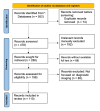Advances in Imaging and Diagnosis of Abdominal Aortic Aneurysm: A Shift in Clinical Practice
- PMID: 40291317
- PMCID: PMC12033972
- DOI: 10.7759/cureus.81321
Advances in Imaging and Diagnosis of Abdominal Aortic Aneurysm: A Shift in Clinical Practice
Abstract
Abdominal aortic aneurysm (AAA) is a potentially life-threatening vascular condition, with rupture carrying a high mortality risk. Advances in imaging technologies have significantly improved the detection, risk stratification, and management of AAA, necessitating periodic updates to international clinical guidelines. This review examines recent advancements in AAA imaging modalities, their role in diagnosis and risk assessment, and evolving screening strategies in response to changing epidemiological trends. A systematic literature search was conducted following Preferred Reporting Items for Systematic Reviews and Meta-Analyses (PRISMA) guidelines, identifying key studies on diagnostic imaging techniques such as ultrasonography (US), computed tomography angiography (CTA), magnetic resonance angiography (MRA), intravascular US (IVUS), positron emission tomography-computed tomography (PET-CT), and artificial intelligence (AI)-driven imaging. US remains the preferred screening tool due to its cost-effectiveness, while CTA is the gold standard for preoperative planning. MRA is an alternative for patients with renal impairment, and emerging technologies such as AI-based imaging, IVUS, and PET-CT enhance risk prediction and surgical decision-making. Declining AAA prevalence, attributed to reduced smoking rates and improved cardiovascular risk management, has led to a shift from population-wide screening to targeted screening based on individual risk factors. Additionally, the standardization of imaging protocols and caliper placement techniques is crucial for accurate measurements and consistent clinical decision-making. As imaging technology continues to evolve, integrating AI, genetic markers, and biomarkers into screening and diagnostic protocols may enable more precise and personalized AAA management. Future research should focus on refining imaging-based risk stratification models to optimize screening and treatment strategies.
Keywords: abdominal aortic aneurysm; artificial intelligence; computed tomography angiography; imaging; risk stratification; screening programs; ultrasonography.
Copyright © 2025, Sidik et al.
Conflict of interest statement
Conflicts of interest: In compliance with the ICMJE uniform disclosure form, all authors declare the following: Payment/services info: All authors have declared that no financial support was received from any organization for the submitted work. Financial relationships: All authors have declared that they have no financial relationships at present or within the previous three years with any organizations that might have an interest in the submitted work. Other relationships: All authors have declared that there are no other relationships or activities that could appear to have influenced the submitted work.
Figures



Similar articles
-
Artificial intelligence in abdominal aortic aneurysm.J Vasc Surg. 2020 Jul;72(1):321-333.e1. doi: 10.1016/j.jvs.2019.12.026. Epub 2020 Feb 21. J Vasc Surg. 2020. PMID: 32093909
-
Endovascular repair of abdominal aortic aneurysm: an evidence-based analysis.Ont Health Technol Assess Ser. 2002;2(1):1-46. Epub 2002 Mar 1. Ont Health Technol Assess Ser. 2002. PMID: 23074438 Free PMC article.
-
Current state of experimental imaging modalities for risk assessment of abdominal aortic aneurysm.J Vasc Surg. 2013 Mar;57(3):851-9. doi: 10.1016/j.jvs.2012.10.097. Epub 2013 Jan 26. J Vasc Surg. 2013. PMID: 23357517 Review.
-
Updates on Ultrasonography Imaging in Abdominal Aortic Aneurysm.Ann Vasc Dis. 2019 Sep 25;12(3):319-322. doi: 10.3400/avd.ra.19-00070. Ann Vasc Dis. 2019. PMID: 31636740 Free PMC article.
-
Ultrasound screening for abdominal aortic aneurysm: an evidence-based analysis.Ont Health Technol Assess Ser. 2006;6(2):1-67. Epub 2006 Jan 1. Ont Health Technol Assess Ser. 2006. PMID: 23074490 Free PMC article.
Cited by
-
Management of a unique hourglass-shaped abdominal aortic aneurysms: A case report.Int J Surg Case Rep. 2025 Jun;131:111383. doi: 10.1016/j.ijscr.2025.111383. Epub 2025 May 3. Int J Surg Case Rep. 2025. PMID: 40327912 Free PMC article.
References
-
- Suggested standards for reporting on arterial aneurysms. Subcommittee on Reporting Standards for Arterial Aneurysms, Ad Hoc Committee on Reporting Standards, Society for Vascular Surgery and North American Chapter, International Society for Cardiovascular Surgery. Johnston KW, Rutherford RB, Tilson MD, Shah DM, Hollier L, Stanley JC. J Vasc Surg. 1991;13:452–458. - PubMed
-
- The value of ultrasonography in the diagnosis of abdominal aortic aneurysm. McGregor JC, Pollock JG, Anton HC. Scott Med J. 1975;20:133–137. - PubMed
-
- Cardiovascular risk prevention and all-cause mortality in primary care patients with an abdominal aortic aneurysm. Bahia SS, Vidal-Diez A, Seshasai SR, et al. Br J Surg. 2016;103:1626–1633. - PubMed
-
- Aneurysm global epidemiology study: public health measures can further reduce abdominal aortic aneurysm mortality. Sidloff D, Stather P, Dattani N, Bown M, Thompson J, Sayers R, Choke E. Circulation. 2014;129:747–753. - PubMed
-
- Surveillance intervals for small abdominal aortic aneurysms: a meta-analysis. Bown MJ, Sweeting MJ, Brown LC, Powell JT, Thompson SG. JAMA. 2013;309:806–813. - PubMed
Publication types
LinkOut - more resources
Full Text Sources
Research Materials
